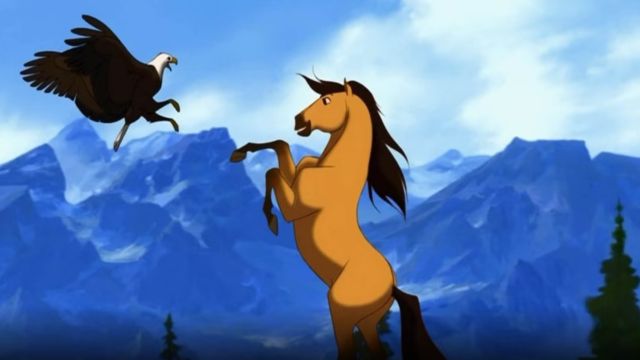Among the numerous legendary films produced by DreamWorks, Spirit: Stallion of the Cimarron remains as a loved classic. The movie tells the story of a horse named Spirit, who grows in the wild but is later taken by horse wranglers.
Spirit forms a bond with a Lakota American Indian named Little Creek, and together, they evade the horse wranglers and strive to liberate other imprisoned horses.
Due to its origins in the Wild West, DreamWorks Spirit: Stallion of the Cimarron may appear to be inspired by a true narrative. It encompasses multiple allusions to American history, including the U.S.
Cavalry’s involvement in the American West, the Lakota people and their settlements, and the construction of the transcontinental railroad. Despite Spirit’s unconventional role as the protagonist in Spirit: Stallion of the Cimarron, the narrative is poignant and uplifting, highlighting themes of liberty and self-identity.
Is the Movie Spirit Inspired by Real Events?
Although Spirit: Stallion of the Cimarron is not a real story, the main character is motivated by a real horse. The horse, officially named Donner, was born from two wild horses took in Oregon.
Donner is a Kiger Mustang, a breed recognized for its distinctive coloration and lineage tracing back to the first horses introduced to America from Spain in the 17th century. Donner, at the age of 28, still alive and resides at Return to Freedom Horse Reserve in central coastal California.
Donner was essential as the animators had no prior experience in creating a horse film like Spirit: Stallion of the Cimarron, necessitating both inspiration and expertise. The DreamWorks team collaborated with Donner for several years to get insights into equine anatomy and behavior.
Ultimately, Spirit’s animators successfully utilized Donner to authentically animate Spirit and other horses. Currently, Spirit assists in educating the general public about America’s mustangs.
The Influence of Historical Events on Spirit: Stallion of the Cimarron
The Colonel, another popular figure, was influenced by authentic American history. The villain in Spirit: Stallion of the Cimarron was inspired by the infamous Colonel George Armstrong Custer, who opposed Native Americans and participated in the American Civil War.
Custer is primarily recognized for “Custer’s Last Stand,” which transpired at the Battle of Little Bighorn when he attempted, but ultimately failed, to seize the territory of the Lakota American Indians.
Despite being a fictional narrative, DreamWorks’ Spirit: Stallion of the Cimarron has created a considerable influence, and its legacy, Donner, continues to inspire others.
Although Custer attained notoriety at the time of his demise, he is still regarded as a controversial character in the American Indian Wars. It is unsurprising that the animated film antagonist Colonel from DreamWorks exhibits a comparable destructive disposition.
Despite being a fictional narrative, DreamWorks’ Spirit: Stallion of the Cimarron has produced a notable influence, and its legacy, Donner, continues to inspire others.
More Animated Movies Inspired by True Facts
Spirit: Stallion of the Cimarron is clearly influenced by actual facts; yet, it is not the only animated film that animates historical facts or narrates a true story via the medium of animation.
Although the majority of animated films, particularly those targeting families and younger audiences, narrate magical and imaginary stories, few draw influence from truth.
The most clear example, surely, is Disney’s Pocahontas. The 1995 release from The House of Mouse, although controversial and maybe less relevant today, was based on historical occurrences.
The historical Pocahontas existed in the early 17th century. However, she was not an older lady when she encountered John Smith, but rather a youngster aged between 10 and 13 years. They also never engaged in a romantic engagement.
The historical Pocahontas did wed an Englishman, John Rolfe, later in her life; additionally, her initial spouse was the actual Kocoum.
Another animated film that, akin to Spirit: Stallion of the Cimarron, draws inspiration from real life and history is 1997’s Anastasia.
Anastasia was the inaugural in-house animated film produced by 20th Century Fox, presenting a highly liberal adaptation of the narrative concerning Duchess Anastasia Nikolaevna of Russia, one of the daughters of Tsar Nicholas II, who was notoriously executed during the Russian Revolution in the early 20th century.
This animated film manipulated the truth significantly, incorporating elements such as Rasputin resurrecting as a lich sorcerer.
Animation is employed to narrate historical tales beyond just children’s films.
Animation is utilized to convey historical narratives beyond just children’s films. Films such as Studio Ghibli’s 1998 Grave of the Fireflies and the 2007 animated French-Iranian movie Persepolis employed the medium to convey the horror and despair experienced in actual wars and conflicts.
Feature-length documentaries, such as the 2008 Israeli docudrama Waltz with Bashir, utilize animation as a vital instrument to depict filmmaker Ari Folman’s experiences during the Lebanon War and other conflicts. Although Spirit: Stallion of the Cimarron is distinguished for its fusion of history and animation, it is not unique in this aspect.
Looking for the impact of history on animated films? Spirit: Stallion of the Cimarron shows how animation can effectively portray historical narratives. For other interesting views on animated films and their real-world connections, please visit our website to browse our complete collection of articles.
